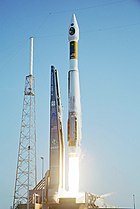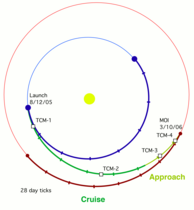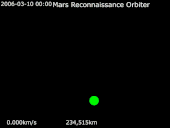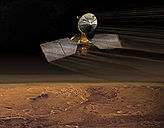Mars Reconnaissance Orbiter
 Mars Reconnaissance Orbiter spacecraft | |
| Mission type | Mars orbiter |
|---|---|
| Operator | NASA / Jet Propulsion Laboratory |
| COSPAR ID | 2005-029A |
| SATCAT no. | 28788 |
| Website | mars nasa |
| Mission duration | 19 years, 3 months and 9 days from launch (18 years, 8 months and 11 days (6648 sols) at Mars) |
| Spacecraft properties | |
| Manufacturer | Lockheed Martin / University of Arizona / Applied Physics Laboratory / Italian Space Agency / Malin Space Science Systems |
| Launch mass | 2,180 kg (4,810 lb)[1] |
| Dry mass | 1,031 kg (2,273 lb) |
| Payload mass | 139 kg (306 lb) |
| Power | 600–2000 watts |
| Start of mission | |
| Launch date | August 12, 2005, 11:43:00 UTC |
| Rocket | Atlas V 401 |
| Launch site | Cape Canaveral SLC-41 |
| Contractor | Lockheed Martin |
| Orbital parameters | |
| Reference system | Areocentric |
| Regime | Sun-synchronous[2] |
| Inclination | 93 degrees[2] |
| Period | 111 minutes |
| Mars orbiter | |
| Orbital insertion | March 10, 2006, 21:24:00 UTC MSD 46990 12:48 AMT |
 Official insignia of the Mars Reconnaissance Orbiter mission | |
The Mars Reconnaissance Orbiter (MRO) is a spacecraft designed to search for the existence of water on Mars and provide support for missions to Mars, as part of NASA's Mars Exploration Program. It was launched from Cape Canaveral on August 12, 2005, at 11:43 UTC and reached Mars on March 10, 2006, at 21:24 UTC. In November 2006, after six months of aerobraking, it entered its final science orbit and began its primary science phase.
Mission objectives include observing the climate of Mars, investigating geologic forces, providing reconnaissance of future landing sites, and relaying data from surface missions back to Earth. To support these objectives, the MRO carries different scientific instruments, including three cameras, two spectrometers and a subsurface radar. As of July 29, 2023, the MRO has returned over 450 terabits of data, helped choose safe landing sites for NASA's Mars landers, discovered pure water ice in new craters and further evidence that water once flowed on the surface on Mars.[3]
The spacecraft continues to operate at Mars, far beyond its intended design life. Due to its critical role as a high-speed data-relay for ground missions, NASA intends to continue the mission as long as possible, at least through the late 2020s. As of November 21, 2024, the MRO has been active at Mars for 6648 sols, or 18 years, 8 months and 11 days, and is the third longest-lived spacecraft to orbit Mars, after 2001 Mars Odyssey and Mars Express.
Pre-launch
[edit]After the failures of the Mars Climate Orbiter and the Mars Polar Lander missions in 1999, NASA reorganized and replanned its Mars Exploration Program. In October 2000, NASA announced its reformulated Mars plans, which reduced the number of planned missions and introduced a new theme, "follow the water". The plans included the Mars Reconnaissance Orbiter (MRO), to be launched in 2005.[4]
On October 3, 2001, NASA chose Lockheed Martin as the primary contractor for the spacecraft's fabrication.[5] By the end of 2001 all of the mission's instruments were selected. There were no major setbacks during the MRO's construction, and the spacecraft was shipped to John F. Kennedy Space Center on May 1, 2005, to prepare it for launch.[6]
Mission objectives
[edit]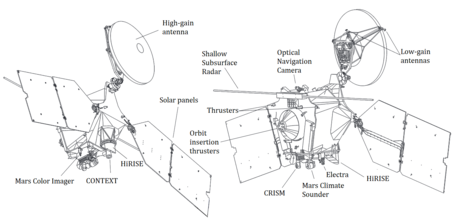
MRO has both scientific and "mission support" objectives. The prime science mission was initially designed to last from November 2006 to November 2008, and the mission support phase from November 2006 to November 2010. Both missions have been extended.[7]
The formal science objectives of MRO are to observe the present climate, particularly its atmospheric circulation and seasonal variations; search for signs of water, both past and present, and understand how it altered the planet's surface; map and characterize the geological forces that shaped the surface.[8]
To support other missions to Mars, the MRO also has mission support objectives. They are to provide data relay services from ground missions back to Earth, and characterize the safety and feasibility of potential future landing sites and Mars rover traverses.[8]
MRO played a key role in choosing safe landing sites for the Phoenix lander in 2008, Mars Science Laboratory / Curiosity rover in 2012, InSight lander in 2018, and the Mars 2020 / Perseverance rover in 2021.[9][10][11]
Launch and orbital insertion
[edit]On August 12, 2005, MRO was launched aboard an Atlas V-401 rocket from Space Launch Complex 41 at Cape Canaveral Air Force Station.[12] The Centaur upper stage of the rocket completed its burns over a 56-minute period and placed MRO into an interplanetary transfer orbit towards Mars.[13]
MRO cruised through interplanetary space for seven and a half months before reaching Mars. While en route, most of the scientific instruments and experiments were tested and calibrated. To ensure proper orbital insertion upon reaching Mars, four trajectory correction maneuvers were planned and a fifth emergency maneuver was discussed.[14] However, only three trajectory correction maneuvers were necessary, which saved 27 kilograms (60 lb) of fuel that would be usable during MRO's extended mission.[15]
MRO began orbital insertion by approaching Mars on March 10, 2006, and passing above its southern hemisphere at an altitude of 370–400 kilometers (230–250 miles). All six of MRO's main engines burned for 27 minutes to slow the probe by 1,000 meters per second (3,300 ft/s). The burn was remarkably accurate, as the insertion route had been designed more than three months prior, with the achieved change in speed only 0.01% short from the design, necessitating an additional 35 second burn time.[16]
Completion of the orbital insertion placed the orbiter in a highly elliptical polar orbit with a period of approximately 35.5 hours.[17] Shortly after insertion, the periapsis – the point in the orbit closest to Mars – was 426 km (265 mi) from the surface[17] (3,806 km (2,365 mi) from the planet's center). The apoapsis – the point in the orbit farthest from Mars – was 44,500 km (27,700 mi) from the surface (47,972 km (29,808 mi) from the planet's center).[18]
When MRO entered orbit, it joined five other active spacecraft that were either in orbit or on the planet's surface: Mars Global Surveyor, Mars Express, 2001 Mars Odyssey, and the two Mars Exploration Rovers (Spirit and Opportunity). This set a new record for the most operational spacecraft in the immediate vicinity of Mars.[19]
On March 30, 2006, MRO began the process of aerobraking, a three-step procedure that halved the fuel needed to achieve a lower, more circular orbit with a shorter period. First, during its first five orbits of the planet (one Earth week), MRO used its thrusters to drop the periapsis of its orbit into aerobraking altitude. Second, while using its thrusters to make minor corrections to its periapsis altitude, MRO maintained aerobraking altitude for 445 planetary orbits (about five Earth months) to reduce the apoapsis of the orbit to 450 kilometers (280 mi). This was done in such a way so as to not heat the spacecraft too much, but also dip enough into the atmosphere to slow the spacecraft down. Third, after the process was complete, MRO used its thrusters to move its periapsis out of the edge of the atmosphere on August 30, 2006.[20][21][22]
In September 2006, MRO fired its thrusters twice more to adjust its final, nearly circular orbit to approximately 250 to 316 km (155 to 196 mi) above the surface, with a period of about 112 minutes.[23][24] The SHARAD radar antennas were deployed on September 16. All of the scientific instruments were tested and most were turned off prior to the solar conjunction that occurred from October 7 to November 6, 2006. This was done to prevent charged particles from the Sun from interfering with signals and potentially endangering the spacecraft.[25] After the conjunction ended the "primary science phase" began.[26]
Timeline
[edit]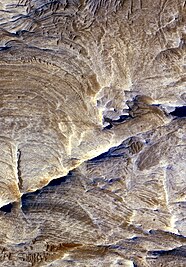
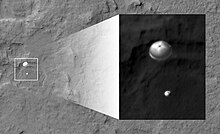

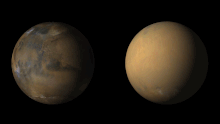
On September 29, 2006 (sol 402), MRO took its first high resolution image from its science orbit. This image is said to resolve items as small as 90 cm (3 feet) in diameter. On October 6, NASA released detailed pictures from the MRO of Victoria crater along with the Opportunity rover on the rim above it.[27] In November, problems began to surface in the operation of two MRO spacecraft instruments. A stepping mechanism in the Mars Climate Sounder (MCS) skipped on multiple occasions resulting in a field of view that was slightly out of position. By December, normal operations of the instrument had been suspended, although a mitigation strategy allows the instrument to continue making most of its intended observations.[28] Also, an increase in noise and resulting bad pixels has been observed in several CCDs of the High Resolution Imaging Science Experiment (HiRISE). Operation of this camera with a longer warm-up time[a] has alleviated the issue. However, the cause is still unknown and may return.[30]
On November 17, 2006, NASA announced the successful test of the MRO as an orbital communications relay. Using the NASA rover Spirit as the point of origin for the transmission, the MRO acted as a relay for transmitting data back to Earth.[31] HiRISE was able to photograph the Phoenix lander during its parachuted descent to Vastitas Borealis on May 25, 2008 (sol 990).[32]
The orbiter continued to experience recurring problems in 2009, including four spontaneous resets, culminating in a four-month shut-down of the spacecraft from August to December.[33] While engineers have not determined the cause of the recurrent resets, they have created new software to help troubleshoot the problem should it recur. Another spontaneous reset occurred in September 2010.[34]
On March 3, 2010, the MRO passed another significant milestone, having transmitted over 100 terabits of data back to Earth, which was more than all other interplanetary probes sent from Earth combined.[35]
In December 2010, the first Extended Mission began. Goals included exploring seasonal processes, searching for surface changes, and providing support for other Martian spacecraft. This lasted until October 2012, after which NASA started the MRO's second Extended Mission, which lasted until October 2014.[34] As of 2023, the MRO has completed five missions, and is currently on its sixth.[36]
On August 6, 2012 (sol 2483), the orbiter passed over Gale crater, the landing site of the Mars Science Laboratory mission, during its EDL phase. It captured an image via the HiRISE camera of the Curiosity rover descending with its backshell and supersonic parachute.[37] In December 2014 and April 2015, Curiosity was photographed again by HiRISE inside Gale Crater.[38]
Another computer anomaly occurred on March 9, 2014, when the MRO put itself into safe mode after an unscheduled swap from one computer to another. The MRO resumed normal science operations four days later. This occurred again in April 11, 2015, after which the MRO returned to full operational capabilities a week later.[34]
NASA reported that the MRO,[39] as well as the Mars Odyssey Orbiter[40] and MAVEN orbiter[41] had a chance to study the Comet Siding Spring flyby on October 19, 2014.[42][43] To minimize risk of damage from the material shed by the comet, the MRO made orbital adjustments on July 2, 2014 and August 27, 2014. During the flyby, the MRO took the best ever pictures of a comet from the Oort cloud and was not damaged.[38]
In January 2015, the MRO discovered and identified the wreckage of Britain's Beagle 2, which was lost during its landing phase in 2003 and was thought to have crashed. The images revealed that Beagle 2 had actually landed safely, but one or two of its solar panels had failed to fully deploy, which blocked the radio antenna.[38][44] In October 2016, the crash site of another lost spacecraft, Schiaparelli EDM, was photographed by the MRO, using both the CTX and HiRISE cameras.[38]
On July 29, 2015, the MRO was placed into a new orbit to provide communications support during the anticipated arrival of the InSight Mars lander mission in September 2016.[45] The maneuver's engine burn lasted for 75 seconds.[46] InSight was delayed and missed the 2016 launch window, but was successfully launched during the next window on May 5, 2018, and landed on November 26, 2018.[47]
Due to the longevity of the mission, a number of MRO components have started deteriorating. From the start of the mission in 2005 to 2017, the MRO had used a miniature inertial measurement unit (MIMU) for altitude and orientation control. After 58,000 hours of use, and limited signs of life, the orbiter switched over to a backup, which, as of 2018, has reached 52,000 hours of use. To conserve the life of the backup, NASA switched from MIMUs to an "all-stellar" mode for routine operations in 2018. The "all-stellar" mode uses cameras and pattern recognition software to determine the location of stars, which can then be used to identify the MRO's orientation.[48] Problems with blurring in pictures from HiRISE and battery degradation also arose in 2017 but have since been resolved.[49] In August 2023, electronic units within the HiRISE's CCD RED4 sensor began to fail as well, and are causing visual artifacts in pictures taken.[50]
In 2017, the cryocoolers used by CRISM completed their lifecycle, limiting the instrument's capabilities to visible wavelengths, instead of its full wavelength range. In 2022, NASA announced the shutdown of CRISM in its entirety, and the instrument was formally retired on April 3, 2023, after creating two final, near global, maps using prior data and a more limited second spectrometer that did not require cryocoolers.[38][51][52]
Instruments
[edit]Three cameras, two spectrometers and a radar are included on the orbiter along with three engineering instruments and two "science-facility experiments", which use data from engineering subsystems to collect science data. Two of the engineering instruments are being used to test and demonstrate new equipment for future missions.[53] The MRO takes around 29,000 images per year.[54]
HiRISE
[edit]The High Resolution Imaging Science Experiment (HiRISE) camera is a 0.5 m (1 ft 8 in) reflecting telescope, the largest ever carried on a deep space mission, and has a resolution of 1 microradian, or 0.3 m (1 ft 0 in) from an altitude of 300 km (190 mi). In comparison, satellite images of Earth are generally available with a resolution of 0.5 m (1 ft 8 in).[55] HiRISE collects images in three color bands, 400 to 600 nm (blue–green or B–G), 550 to 850 nm (red) and 800 to 1,000 nm (near infrared).[56]
Red color images are 20,264 pixels across (6 km (3.7 mi) wide), and B–G and NIR are 4,048 pixels across (1.2 km (0.75 mi) wide). HiRISE's onboard computer reads these lines in time with the orbiter's ground speed, and images are potentially unlimited in length. Practically however, their length is limited by the computer's 28 Gb memory capacity, and the nominal maximum size is 20,000 × 40,000 pixels (800 megapixels) and 4,000 × 40,000 pixels (160 megapixels) for B–G and NIR images. Each 16.4 Gb image is compressed to 5 Gb before transmission and release to the general public on the HiRISE website in JPEG 2000 format.[24][57] To facilitate the mapping of potential landing sites, HiRISE can produce stereo pairs of images from which topography can be calculated to an accuracy of 0.25 m (9.8 in).[58] HiRISE was built by Ball Aerospace & Technologies Corp.[59]
CTX
[edit]The Context Camera (CTX) provides grayscale images (500 to 800 nm) with a pixel resolution up to about 6 m (20 ft). CTX is designed to provide context maps for the targeted observations of HiRISE and CRISM, and is also used to mosaic large areas of Mars, monitor a number of locations for changes over time, and to acquire stereo (3D) coverage of key regions and potential future landing sites.[60][61] The optics of CTX consist of a 350 mm (14 in) focal length Maksutov Cassegrain telescope with a 5,064 pixel wide line array CCD. The instrument takes pictures 30 km (19 mi) wide and has enough internal memory to store an image 160 km (99 mi) long before loading it into the main computer.[62] The camera was built, and is operated by Malin Space Science Systems. CTX had mapped more than 99% of Mars by March 2017 and helped create an interactive map of Mars in 2023.[63][64]
MARCI
[edit]The Mars Color Imager (MARCI) is a wide-angle, relatively low-resolution camera that views the surface of Mars in five visible and two ultraviolet bands. Each day, MARCI collects about 84 images and produces a global map with pixel resolutions of 1 to 10 km (0.62 to 6.21 mi). This map provides a weekly weather report for Mars, helps to characterize its seasonal and annual variations, and maps the presence of water vapor and ozone in its atmosphere.[65] The camera was built and is operated by Malin Space Science Systems. It has a 180-degree fisheye lens with the seven color filters bonded directly on a single CCD sensor.[66][67] The same MARCI camera was onboard Mars Climate Orbiter launched in 1998.[68]
CRISM
[edit]The Compact Reconnaissance Imaging Spectrometer for Mars (CRISM) instrument is a visible and near infrared spectrometer that is used to produce detailed maps of the surface mineralogy of Mars.[69] It operates from 362 to 3920 nm, measures the spectrum in 544 channels (each 6.55 nm wide), and has a resolution of 18 m (59 ft) at an altitude of 300 km (190 mi).[69][70] CRISM is being used to identify minerals and chemicals indicative of the past or present existence of water on the surface of Mars. These materials include iron oxides, phyllosilicates, and carbonates, which have characteristic patterns in their visible-infrared energy.[71] The CRISM instrument was shut down on April 3, 2023.[51]
MCS
[edit]The Mars Climate Sounder (MCS) is a radiometer that looks both down and horizontally through the atmosphere in order to quantify the atmosphere's vertical variations. It has one visible/near infrared channel (0.3 to 3.0 μm) and eight far infrared (12 to 50 μm) channels selected for the purpose. MCS observes the atmosphere on the horizon of Mars (as viewed from MRO) by breaking it up into vertical slices and taking measurements within each slice in 5 km (3.1 mi) increments. These measurements are assembled into daily global weather maps to show the basic variables of Martian weather: temperature, pressure, humidity, and dust density.[72] The MCS weighs roughly 9 kg (20 lb) and began operation in November 2006.[73][74] Since beginning operation, it has helped create maps of mesospheric clouds,[75] study and categorize dust storms,[76] and provide direct evidence of carbon dioxide snow on Mars.[77]
This instrument, supplied by NASA's Jet Propulsion Laboratory (JPL), is an updated version of a heavier, larger instrument originally developed at JPL for the 1992 Mars Observer and 1998 Mars Climate Orbiter missions,[78] which both failed.[79]
SHARAD
[edit]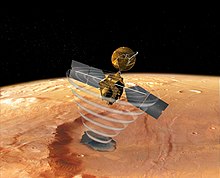
The Shallow Radar (SHARAD) sounder experiment onboard MRO is designed to probe the internal structure of the Martian polar ice caps. It also gathers planet-wide information about underground layers of regolith, rock, and ice that might be accessible from the surface. SHARAD emits HF radio waves between 15 and 25 MHz, a range that allows it to resolve layers as thin as 7 m (23 ft) to a maximum depth of 3 km (1.864 mi). It has a horizontal resolution of 0.3 to 3 km (0.2 to 1.9 mi).[80] SHARAD is designed to complement the Mars Express MARSIS instrument, which has coarser resolution but penetrates to a much greater depth. Both SHARAD and MARSIS were made by the Italian Space Agency.[81]
Engineering instruments and experiments
[edit]In addition to its imaging equipment, MRO carries three engineering instruments. The Electra communications package is a UHF software-defined radio that provides a flexible platform for evolving relay capabilities.[82] It is designed to communicate with other spacecraft as they approach, land, and operate on Mars. In addition to protocol controlled inter-spacecraft data links of 1 kbit/s to 2 Mbit/s, Electra also provides Doppler data collection, open loop recording and a highly accurate timing service based on an ultra-stable oscillator.[83][84] Doppler information for approaching vehicles can be used for final descent targeting or descent and landing trajectory recreation. Doppler information on landed vehicles allows scientists to accurately determine the surface location of Mars landers and rovers. The two Mars Exploration Rover (MER) spacecraft utilized an earlier generation UHF relay radio providing similar functions through the Mars Odyssey orbiter. The Electra radio has relayed information to and from the MER spacecraft, Phoenix lander and Curiosity rover.[85]
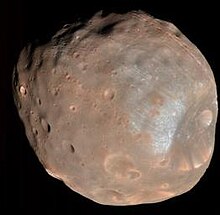
During the cruise phase, the MRO also used the Ka band Telecommunications Experiment Package to demonstrate a less power-intensive way to communicate with Earth.[87]
The Optical Navigation Camera images the Martian moons, Phobos and Deimos, against background stars to precisely determine MRO's orbit. Although this is not critical, it was included as a technology test for future orbiting and landing of spacecraft.[88] The Optical Navigation Camera was tested successfully in February and March 2006.[89]
Two additional science investigations are also on the spacecraft. The Gravity Field Investigation Package measures variations in the Martian gravitational field through variations in the spacecraft's speed. Speed changes are detected by measuring doppler shifts in MRO's radio signals received on Earth. Data from this investigation can be used to understand the subsurface geology of Mars, determine the density of the atmosphere and track seasonal changes in the location of carbon dioxide deposited on the surface.[90]
The Atmospheric Structure Investigation used sensitive onboard accelerometers to deduce the in situ atmospheric density of Mars during aerobraking. The measurements helped provide greater understanding of seasonal wind variations, the effects of dust storms, and the structure of the atmosphere.[91]
Spacecraft Systems
[edit]
Structure
[edit]Workers at Lockheed Martin Space Systems in Denver assembled the spacecraft structure and attached the instruments. Instruments were constructed at the Jet Propulsion Laboratory, the University of Arizona Lunar and Planetary Laboratory in Tucson, Arizona, Johns Hopkins University Applied Physics Laboratory in Laurel, Maryland, the Italian Space Agency in Rome, and Malin Space Science Systems in San Diego.[92]
The structure is made mostly of carbon composites and aluminum-honeycombed plates. The titanium fuel tank takes up most of the volume and mass of the spacecraft and provides most of its structural integrity.[93] The spacecraft's total mass is less than 2,180 kg (4,810 lb) with an unfueled dry mass less than 1,031 kg (2,273 lb).[94]
Power systems
[edit]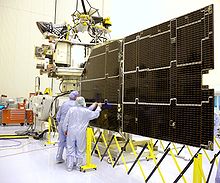
MRO gets all of its electrical power from two solar panels, each of which can move independently around two axes (up-down, or left-right rotation). Each solar panel measures 5.35 m × 2.53 m (17.6 ft × 8.3 ft) and has 9.5 m2 (102 sq ft) covered with 3,744 individual photovoltaic cells.[95][83] Its high-efficiency solar cells are able to convert more than 26% of the energy it receives from the Sun directly into electricity and are connected together to produce a total output of 32 volts. Whilst orbiting Mars, the panels together produce 600–2000[b] watts of power;[96][83][8] in contrast, the panels would generate 6,000 watts in a comparable Earth orbit by being closer to the Sun.[95][83]
MRO has two rechargeable nickel-hydrogen batteries used to power the spacecraft when it is not facing the Sun. Each battery has an energy storage capacity of 50 ampere hours (180 kC). The full range of the batteries cannot be used due to voltage constraints on the spacecraft, but allows the operators to extend the battery life—a valuable capability, given that battery drain is one of the most common causes of long-term satellite failure. Planners anticipate that only 40% of the batteries' capacities will be required during the lifetime of the spacecraft.[95]
Electronic systems
[edit]MRO's main computer is a 133 MHz, 10.4 million transistor, 32-bit, RAD750 processor, a radiation-hardened version of a PowerPC 750 or G3 processor with a purpose-built motherboard.[97] The operating system software is VxWorks and has extensive fault protection protocols and monitoring.[98]
Data is stored in a 160 Gbit (20 GB) flash memory module consisting of over 700 memory chips, each with a 256 Mbit capacity. This memory capacity is not actually that large considering the amount of data to be acquired; for example, a single image from the HiRISE camera can be as large as 28 Gb.[98]
Telecommunications system
[edit]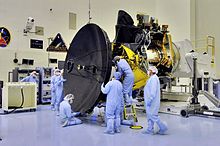

When it was launched, the Telecom Subsystem on MRO was the best digital communication system sent into deep space, and for the first time used capacity-approaching turbo-codes. It was more powerful than any previous deep space mission, and is able to transmit data more than ten times faster than previous Mars missions.[99] Along with the Electra communications package, the system consists of a very large (3 m (9.8 ft)) antenna, which is used to transmit data through the Deep Space Network via X-band frequencies at 8.41 GHz. It also demonstrates the use of the Ka band at 32 GHz for higher data rates.[100] Maximum transmission speed from Mars can be as high as 6 Mbit/s, but averages between 0.5 and 4 Mbit/s.[99] The spacecraft carries two 100-watt X-band Travelling Wave Tube Amplifiers (TWTA) (one of which is a backup), one 35-watt Ka-band amplifier, and two Small Deep Space Transponders (SDSTs).[101][102]
Two smaller low-gain antennas are also present for lower-rate communication during emergencies and special events. These antennas do not have focusing dishes and can transmit and receive from any direction. They are an important backup system to ensure that MRO can always be reached, even if its main antenna is pointed away from the Earth.[103][104]
The Ka band subsystem was used to show how such a system could be used by spacecraft in the future. Due to lack of spectrum at 8.41 GHz X-band, future high-rate deep space missions will use 32 GHz Ka-band. NASA Deep Space Network (DSN) implemented Ka-band receiving capabilities at all three of its complexes (Goldstone, Canberra and Madrid) over its 34-m beam-waveguide (BWG) antenna subnet.[100] Ka-band tests were also planned during the science phase, but during aerobraking a switch failed, limiting the X-band high gain antenna to a single amplifier.[105] If this amplifier fails all high-speed X-band communications will be lost. The Ka downlink is the only remaining backup for this functionality, and since the Ka-band capability of one of the SDST transponders has already failed,[106] (and the other might have the same problem) JPL decided to halt all Ka-band demonstrations and hold the remaining capability in reserve.[107]
By November 2013, the MRO had passed 200 terabits in the amount of science data returned. The data returned by the mission is more than three times the total data returned via NASA's Deep Space Network for all the other missions managed by NASA's Jet Propulsion Laboratory over the past 10 years.[108]

Propulsion and attitude control
[edit]The spacecraft uses a 1,175 L (258 imp gal; 310 US gal) fuel tank filled with 1,187 kg (2,617 lb) of hydrazine monopropellant. Fuel pressure is regulated by adding pressurized helium gas from an external tank. Seventy percent of the propellant was used for orbital insertion,[109] and it has enough propellant to keep functioning into the 2030s.[110]
MRO has 20 rocket engine thrusters on board. Six large thrusters each produce 170 N (38 lbf) of thrust for a total of 1,020 N (230 lbf) meant mainly for orbital insertion. These thrusters were originally designed for the Mars Surveyor 2001 Lander. Six medium thrusters each produce 22 N (4.9 lbf) of thrust for trajectory correction maneuvers and attitude control during orbit insertion. Finally, eight small thrusters each produce 0.9 N (0.20 lbf) of thrust for attitude control during normal operations.[109]
Four reaction wheels are also used for precise attitude control during activities requiring a highly stable platform, such as high-resolution imaging, in which even small motions can cause blurring of the image. Each wheel is used for one axis of motion. The fourth wheel is a backup in case one of the other three wheels fails. Each wheel weighs 10 kg (22 lb) and can be spun as fast as 100 Hz or 6,000 rpm.[109][111]
In order to determine the spacecraft's orbit and facilitate maneuvers, 16 Sun sensors – eight primaries and eight backups – are placed around the spacecraft to calibrate solar direction relative to the orbiter's frame. Two star trackers, digital cameras used to map the position of catalogued stars, provide NASA with full, three-axis knowledge of the spacecraft orientation and attitude. A primary and backup Miniature Inertial Measurement Unit (MIMU), provided by Honeywell, measures changes to the spacecraft attitude as well as any non-gravitationally induced changes to its linear velocity. Each MIMU is a combination of three accelerometers and three ring-laser gyroscopes. These systems are all critically important to MRO, as it must be able to point its camera to a very high precision in order to take the high-quality pictures that the mission requires. It has also been specifically designed to minimize any vibrations on the spacecraft, so as to allow its instruments to take images without any distortions caused by vibrations.[112][113][114]
Cost
[edit]
The total cost of the MRO through the end of its prime mission was $716.6 million. Of this amount, $416.6 million was spent on spacecraft development, approximately $90 million for its launch, and $210 million for 5 years of mission operations. Since 2011, MRO's annual operations costs are, on average, $31 million per year, when adjusted for inflation.[115]
Discoveries
[edit]Ice
[edit]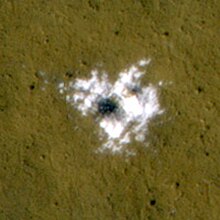
An article in the journal Science in September 2009,[116] reported that some new craters on Mars have excavated relatively pure water ice. After being exposed, the ice gradually fades as it sublimates away. These new craters were found and dated by the CTX camera, and the identification of the ice was confirmed using CRISM. The ice was found in a five locations, three of which were in the Cebrenia quadrangle. These locations are 55°34′N 150°37′E / 55.57°N 150.62°E; 43°17′N 176°54′E / 43.28°N 176.9°E; and 45°00′N 164°30′E / 45°N 164.5°E. Two others are in the Diacria quadrangle: 46°42′N 176°48′E / 46.7°N 176.8°E and 46°20′N 176°54′E / 46.33°N 176.9°E.[117][118]
Radar results from SHARAD suggested that features termed lobate debris aprons (LDAs) contain large amounts of water ice. Of interest from the days of the Viking Orbiters, these LDA are aprons of material surrounding cliffs. They have a convex topography and a gentle slope; this suggests flow away from the steep source cliff. In addition, lobate debris aprons can show surface lineations just as rock glaciers on the Earth.[119] SHARAD has provided strong evidence that the LDAs in Hellas Planitia are glaciers that are covered with a thin layer of debris (i.e. rocks and dust); a strong reflection from the top and base of LDAs was observed, suggesting that pure water ice makes up the bulk of the formation (between the two reflections).[120] Based on the experiments of the Phoenix lander and the studies of the Mars Odyssey from orbit, water ice is known to exist just under the surface of Mars in the far north and south (high latitudes).[121][122]
Chloride deposits and aqueous minerals
[edit]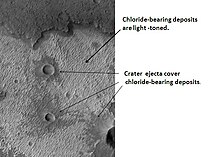
Using data from Mars Global Surveyor, Mars Odyssey, and the MRO, scientists have found widespread deposits of chloride minerals. Evidence suggests that the deposits were formed from the evaporation of mineral enriched waters. The research suggests that lakes may have been scattered over large areas of the Martian surface. Usually, chlorides are the last minerals to come out of solution. Carbonates, sulfates, and silica should precipitate out ahead of them. Sulfates and silica have been found by the Mars rovers on the surface. Places with chloride minerals may have once held various life forms. Furthermore, such areas could preserve traces of ancient life.[123]
In 2009, a group of scientists from the CRISM team reported on nine to ten different classes of minerals formed in the presence of water. Different types of clays (also called phyllosilicates) were found in many locations. The phyllosilicates identified included aluminum smectite, iron/magnesium smectite, kaolinite, prehnite, and chlorite. Rocks containing carbonate were found around the Isidis basin. Carbonates belong to one class in which life could have developed. Areas around Valles Marineris were found to contain hydrated silica and hydrated sulfates. The researchers identified hydrated sulfates and ferric minerals in Terra Meridiani and in Valles Marineris. Other minerals found on Mars were jarosite, alunite, hematite, opal, and gypsum. Two to five of the mineral classes were formed with the right pH and sufficient water to permit life to grow.[124]
Recurring slope lineae
[edit]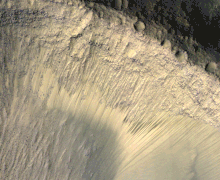
On August 4, 2011 (sol 2125), NASA announced that MRO had detected dark streaks on slopes, known as recurring slope lineae caused by what appeared to be flowing salty water on the surface or subsurface of Mars.[125] On September 28, 2015, this finding was confirmed at a special NASA news conference.[126][127] In 2017, however, further research suggested that the dark streaks were created by grains of sand and dust slipping down slopes, and not water darkening the ground.[128]
See also
[edit]- Exploration of Mars
- Geography of Mars – Delineation and characterization of Martian regions
- HiWish program – NASA program for public suggestions for MRO images
Notes
[edit]- ^ Due to the coldness of space, spacecraft instruments need to be "warmed up" to operate properly.[29]
- ^ Various figures are given for the power, ranging from 600 W to 2000 W at the aphelion to 1000 W at an unspecified location in the MRO's orbit. Due to the conflicting information from reliable sources, a range has been used, instead of an exact number.[96][83][8]
References
[edit]![]() This article incorporates public domain material from websites or documents of the National Aeronautics and Space Administration.
This article incorporates public domain material from websites or documents of the National Aeronautics and Space Administration.
- ^ "Mars Reconnaissance Orbiter". NASA's Solar System Exploration website. Archived from the original on September 8, 2018. Retrieved December 1, 2022.
- ^ a b Lyons, Daniel T. (August 5–8, 2002). "Mars Reconnaissance Orbiter: Aerobraking Reference Trajectory" (PDF). AIAA/AAS Astrodynamics Specialist Conference and Exhibit. Archived from the original (PDF) on October 18, 2011. Retrieved March 9, 2012.
- ^ "Mars Reconnaissance Orbiter". NASA. Archived from the original on July 29, 2023. Retrieved July 29, 2023.
- ^ "NASA Unveils Plans for 21st Century Mars Campaign". Space.com. Archived from the original on December 10, 2004. Retrieved July 4, 2006.
- ^ "NASA Picks Lockheed Martin to Build 2005 Mars Craft". Space.com. Archived from the original on February 12, 2006. Retrieved July 4, 2006.
- ^ "Moving Day For Mars Reconnaissance Orbiter". Space.com. May 2005. Archived from the original on November 25, 2006. Retrieved July 4, 2006.
- ^ "428154main_Planetary_Science.pdf" (PDF). NASA. p. 47. Archived (PDF) from the original on May 10, 2017. Retrieved July 29, 2023.
- ^ a b c d Zurek, Richard W.; Smrekar, Suzanne E. (2007). "An overview of the Mars Reconnaissance Orbiter (MRO) science mission". Journal of Geophysical Research: Planets. 112 (E5): E05S01. Bibcode:2007JGRE..112.5S01Z. doi:10.1029/2006JE002701. ISSN 2156-2202.
- ^ Sharrow, R. (July 24, 2006). "pds-geosciences.wustl.edu/missions/mro/docs/mro_mission.txt". pds-geosciences.wustl.edu. Archived from the original on December 27, 2021. Retrieved July 29, 2023.
- ^ Greicius, Tony (May 2, 2018). "NASA Evaluates Four Candidate Sites for 2016 Mars Mission". NASA. Archived from the original on February 28, 2014. Retrieved July 29, 2023.
- ^ Grant, John A.; Golombek, Matthew P.; Wilson, Sharon A.; Farley, Kenneth A.; Williford, Ken H.; Chen, Al (December 1, 2018). "The science process for selecting the landing site for the 2020 Mars rover". Planetary and Space Science. 164: 106–126. Bibcode:2018P&SS..164..106G. doi:10.1016/j.pss.2018.07.001. ISSN 0032-0633. S2CID 125118346. Archived from the original on August 4, 2023. Retrieved July 29, 2023.
- ^ "ILS To Launch Mars Reconnaissance Orbiter For NASA on Atlas V". International Launch Services. Archived from the original on March 11, 2006. Retrieved June 30, 2006.
- ^ "NASA's Multipurpose Mars Mission Successfully Launched". NASA Press Release from August 12, 2005. Archived from the original on May 10, 2013. Retrieved May 30, 2006.
- ^ "Approach: Trajectory Correction Maneuvers 4, 5, & 6 – NASA". mars.nasa.gov. Archived from the original on August 18, 2023. Retrieved August 18, 2023.
- ^ Leary, Warren E. (March 11, 2006). "U.S. Spacecraft Enters Orbit Around Mars". New York Times. Archived from the original on April 24, 2009. Retrieved March 31, 2012.
- ^ "Mars Reconnaissance Orbiter Interplanetary Cruise Navigation" (PDF). p. 16. Archived (PDF) from the original on May 30, 2022. Retrieved August 21, 2022.
- ^ a b "New Mars Orbiter Ready for Action". Space.com. March 21, 2006. Archived from the original on November 25, 2006. Retrieved May 28, 2006.
- ^ Zurek, Richard W.; Smrekar, Suzanne E. (2007). "An overview of the Mars Reconnaissance Orbiter (MRO) science mission". Journal of Geophysical Research: Planets. 112 (E5): 15. Bibcode:2007JGRE..112.5S01Z. doi:10.1029/2006JE002701. ISSN 2156-2202.
- ^ "Every mission to Mars ever". The Planetary Society. Archived from the original on July 12, 2018. Retrieved August 22, 2023.
- ^ "Mission Timeline: Aerobraking". Mars Reconnaissance Orbiter: The Mission. Archived from the original on March 6, 2006. Retrieved May 28, 2006.
- ^ "Mars Orbiter Successfully Makes Big Burn". Space.com. August 30, 2006. Archived from the original on July 8, 2008. Retrieved August 30, 2006.
- ^ "NASA – NASA Mars Reconnaissance Orbiter Reaches Planned Flight Path". www.nasa.gov. Archived from the original on October 29, 2006. Retrieved August 18, 2023.
- ^ "Mars Reconnaissance Orbiter Reaches Planned Flight Path". JPL. Archived from the original on September 28, 2006. Retrieved September 13, 2006.
- ^ a b "Fact Sheet: HiRISE" (PDF). National Air and Space Museum. Archived from the original (PDF) on June 21, 2013. Retrieved February 18, 2006. (PDF)
- ^ "Solar Conjunction | Mars in our Night Sky". NASA Mars Exploration. Archived from the original on August 20, 2021. Retrieved August 18, 2023.
- ^ Zurek, Richard W.; Smrekar, Suzanne E. (May 12, 2007). "An overview of the Mars Reconnaissance Orbiter (MRO) science mission". Journal of Geophysical Research. 112 (E5): E05S01. Bibcode:2007JGRE..112.5S01Z. doi:10.1029/2006JE002701. ISSN 0148-0227.
- ^ "Mars orbiter looks down on rover". October 6, 2006. Archived from the original on October 21, 2007. Retrieved October 9, 2006.
- ^ "Mars Climate Sounder Team Website – What We Do | The Planetary Society". Archived from the original on August 27, 2009. Retrieved January 16, 2008.
- ^ "Thermal Systems – NASA". mars.nasa.gov. Archived from the original on October 1, 2023. Retrieved August 21, 2023.
- ^ "Deterioration of the sharpest eyes on Mars has stopped – mars-rovers – March 24, 2007 – New Scientist Space". Archived from the original on January 20, 2023. Retrieved September 4, 2017.
- ^ "NASA's Newest Mars Orbiter Passes Communications Relay Test". NASA Mars Exploration Program. November 17, 2006. Archived from the original on January 20, 2023. Retrieved January 20, 2023.
- ^ "PIA10705: Phoenix Descending with Crater in the Background". NASA JPL Photojournal. May 27, 2008. Archived from the original on August 7, 2022. Retrieved January 20, 2023.
- ^ Morris, Jefferson (January 4, 2010). "Power Cycle". Aviation Week. McGraw-Hill: 17.
- ^ a b c "In Depth | Mars Reconnaissance Orbiter". NASA Solar System Exploration. Archived from the original on April 3, 2020. Retrieved February 21, 2023.
- ^ "Scientists Wowed by Data From Mars Probe". NBC News. March 4, 2010. Archived from the original on April 14, 2013. Retrieved April 21, 2013.
- ^ "NASA Extends Exploration for 8 Planetary Science Missions". NASA Mars Exploration. April 25, 2022. Archived from the original on July 8, 2023. Retrieved July 7, 2023.
- ^ "Curiosity Spotted on Parachute by Orbiter". NASA MARS Exploration Program. August 6, 2012. Archived from the original on December 1, 2022. Retrieved January 20, 2023.
- ^ a b c d e "Mars Reconnaissance Orbiter – In Depth". NASA Solar System Exploration. Archived from the original on September 8, 2018. Retrieved April 24, 2020.
- ^ Webster, Guy; Brown, Dwayne (October 19, 2014). "NASA's Mars Reconnaissance Orbiter Studies Comet Flyby". NASA. Archived from the original on June 9, 2017. Retrieved October 20, 2014.
- ^ Webster, Guy; Brown, Dwayne (October 19, 2014). "NASA's Mars Odyssey Orbiter Watches Comet Fly Near". NASA. Archived from the original on May 8, 2017. Retrieved October 20, 2014.
- ^ Jones, Nancy; Steigerwald, Bill; Webster, Guy; Brown, Dwayne (October 19, 2014). "NASA's MAVEN Studies Passing Comet and Its Effects". NASA. Archived from the original on July 4, 2017. Retrieved October 20, 2014.
- ^ Webster, Guy; Brown, Dwayne; Jones, Nancy; Steigerwald, Bill (October 19, 2014). "All Three NASA Mars Orbiters Healthy After Comet Flyby". NASA. Archived from the original on July 3, 2017. Retrieved October 20, 2014.
- ^ "A Comet's Brush With Mars". New York Times. Agence France-Presse. October 19, 2014. Archived from the original on October 27, 2014. Retrieved October 20, 2014.
- ^ Davis, Nicola (November 11, 2016). "Beagle 2 Mars probe was 'excruciatingly close' to success, new research reveals". The Guardian. ISSN 0261-3077. Archived from the original on March 7, 2023. Retrieved March 7, 2023.
- ^ Szondy, David (July 30, 2015). "Mars orbiter prepares for next year's InSight lander arrival". New Atlas. Archived from the original on July 30, 2015. Retrieved January 21, 2023.
- ^ "NASA Mars Orbiter Preparing for Mars Lander's 2016 Arrival". July 28, 2015. Archived from the original on July 30, 2015. Retrieved July 30, 2015.
- ^ "NASA InSight lander arrives on Martian surface". NASA's Mars Exploration Program. Archived from the original on August 6, 2019. Retrieved November 26, 2018.
- ^ "Mars Reconnaissance Orbiter Preparing for Years Ahead". NASA/JPL. JPL Press Office. February 9, 2018. Archived from the original on August 3, 2020. Retrieved April 24, 2020.
- ^ McEwen, Alfred (April 23, 2019). "HiRISE Team Overcomes Imaging Glitches as Mars Reconnaissance Orbiter Eyes another Decade in Orbit". The Planetary Society. Archived from the original on February 5, 2023. Retrieved August 4, 2023.
- ^ "HiRISE | Image Catalog". www.uahirise.org. Archived from the original on April 20, 2020. Retrieved October 31, 2023.
- ^ a b "NASA Extends Exploration for 8 Planetary Science Missions". April 25, 2022. Archived from the original on April 26, 2022. Retrieved April 26, 2022.
- ^ Hartono, Naomi (April 25, 2023). "NASA Retires Mineral Mapping Instrument on Mars Orbiter". NASA. Archived from the original on June 22, 2023. Retrieved June 23, 2023.
- ^ "Spacecraft Parts: Instruments". Mars Reconnaissance Orbiter Website. Archived from the original on March 8, 2005. Retrieved February 20, 2005.
- ^ "Mars Reconnaissance Orbiter By the Numbers". NASA Mars Exploration. Archived from the original on August 18, 2023. Retrieved August 18, 2023.
- ^ Jagula, Dexter (February 19, 2022). "SATELLITE IMAGERY FOR EVERYONE". IEEE Spectrum. Archived from the original on July 7, 2023. Retrieved July 6, 2023.
- ^ "MRO HiRISE Camera Specifications". HiRISE website. Archived from the original on May 10, 2013. Retrieved January 2, 2006.
- ^ "HiRISE: Instrument Development" (PDF). NASA Ames Research Center website. Archived (PDF) from the original on May 10, 2013. Retrieved February 7, 2006. (PDF)
- ^ "HiRISE". HiRISE website. Archived from the original on November 15, 2019. Retrieved May 28, 2006.
- ^ "HiRISE Views NASA's InSight and Curiosity on Mars". NASA Mars Exploration. October 16, 2019. Archived from the original on July 29, 2023. Retrieved July 29, 2023.
- ^ Malin, M. C.; et al. (2007). "Context Camera Investigation on board the Mars Reconnaissance Orbiter". Journal of Geophysical Research. 112 (E05S04): 1–25. Bibcode:2007JGRE..112.5S04M. doi:10.1029/2006je002808. Archived from the original on January 20, 2023. Retrieved August 3, 2010.
- ^ Harrison, Tanya N.; Malin, Michael C.; Edgett, Kenneth S. (2009). "Present-day activity, monitoring, and documentation of gullies with the Mars Reconnaissance Orbiter (MRO) Context Camera (CTX)". Geological Society of America Abstracts with Programs. 41 (7): 267. Bibcode:2009GSAA...41..267H.
- ^ "MRO Context Imager (CTX) Instrument Description". Malin Space Science Systems website. Archived from the original on June 22, 2006. Retrieved June 6, 2006.
- ^ "A Decade of Compiling the Sharpest Mars Map". NASA Mars Exploration. Archived from the original on June 8, 2023. Retrieved August 4, 2023.
- ^ Greicius, Tony (April 4, 2023). "New Interactive Mosaic Uses NASA Imagery to Show Mars in Vivid Detail". NASA. Archived from the original on May 19, 2023. Retrieved August 4, 2023.
- ^ "Spacecraft Parts: Instruments: MARCI". MARCI website. Archived from the original on May 5, 2006. Retrieved June 2, 2006.
- ^ "Mars Color Imager: How MARCI Takes Color Images, MRO MARCI Release No. MARCI2-3, 13 April 2006". Archived from the original on May 13, 2013. Retrieved March 13, 2012.
- ^ "NASA – NSSDCA – Experiment – Details". nssdc.gsfc.nasa.gov. Archived from the original on April 14, 2020. Retrieved February 2, 2023.
 This article incorporates text from this source, which is in the public domain.
This article incorporates text from this source, which is in the public domain.
- ^ "MARS RECONNAISSANCE ORBITER (MRO) MARS COLOR IMAGER (MARCI) INSTRUMENT DESCRIPTION". msss.com. Malin Space Science Systems. Archived from the original on February 2, 2023. Retrieved February 2, 2023.
- ^ a b "CRISM Instrument Overview". CRISM Instrument Website. Archived from the original on March 7, 2005. Retrieved April 2, 2005.
- ^ "CRISM". NASA MARS Reconnaissance Orbiter. Archived from the original on November 12, 2022. Retrieved January 20, 2023.
- ^ Murchie, Scott L.; Mustard, John F.; Ehlmann, Bethany L.; Milliken, Ralph E.; Bishop, Janice L.; McKeown, Nancy K.; Noe Dobrea, Eldar Z.; Seelos, Frank P.; Buczkowski, Debra L.; Wiseman, Sandra M.; Arvidson, Raymond E.; Wray, James J.; Swayze, Gregg; Clark, Roger N.; Des Marais, David J. (September 22, 2009). "A synthesis of Martian aqueous mineralogy after 1 Mars year of observations from the Mars Reconnaissance Orbiter". Journal of Geophysical Research. 114 (E2): E00D06. Bibcode:2009JGRE..114.0D06M. doi:10.1029/2009JE003342. ISSN 0148-0227.
- ^ "Spacecraft Parts: Instruments: MCS". CRISM Instrument Website. Archived from the original on January 4, 2006. Retrieved May 28, 2006.
- ^ Jau, Bruno M. (March 2008). "Mechanical Description of the Mars Climate Sounder Instrument". 2008 IEEE Aerospace Conference. IEEE. pp. 1–8. doi:10.1109/aero.2008.4526543. ISBN 978-1-4244-1487-1.
- ^ "MRO Science Instruments". NASA. Archived from the original on June 29, 2024. Retrieved July 1, 2024.
- ^ Lea, Robert (November 6, 2023). "Citizen scientists detect patterns in clouds over Mars". Space.com. Archived from the original on December 9, 2023. Retrieved July 1, 2024.
- ^ Kass, D. M.; Schofield, J. T.; Kleinböhl, A.; McCleese, D. J.; Heavens, N. G.; Shirley, J. H.; Steele, L. J. (December 16, 2020). "Mars Climate Sounder Observation of Mars' 2018 Global Dust Storm". Geophysical Research Letters. 47 (23). Bibcode:2020GeoRL..4783931K. doi:10.1029/2019GL083931. ISSN 0094-8276. Archived from the original on May 6, 2023. Retrieved July 1, 2024.
- ^ Cray, Daniel (September 17, 2012). "Martian Blizzard! It's Snowing on the Red Planet". Time. ISSN 0040-781X. Archived from the original on March 5, 2024. Retrieved July 1, 2024.
- ^ "MRO MCS". Planetary Data System. Archived from the original on January 20, 2023. Retrieved January 20, 2023.
- ^ McCleese, D. J.; Schofield, J. T.; Taylor, F. W.; Calcutt, S. B.; Foote, M. C.; Kass, D. M.; Leovy, C. B.; Paige, D. A.; Read, P. L.; Zurek, R. W. (May 2007). "Mars Climate Sounder: An investigation of thermal and water vapor structure, dust and condensate distributions in the atmosphere, and energy balance of the polar regions". Journal of Geophysical Research. 112 (E05S06). Bibcode:2007JGRE..112.5S06M. doi:10.1029/2006JE002790. ISSN 0148-0227.
- ^ NASA MRO web site (July 15, 2008). SHARAD: MRO Spacecraft parts Archived June 4, 2008, at the Wayback Machine
- ^ "SHARAD". mars.nasa.gov. NASA. Archived from the original on March 18, 2020. Retrieved April 24, 2020.
- ^ Charles D. Edwards Jr.; Thomas C. Jedrey; Eric Schwartzbaum; and Ann S. Devereaux; Ramon DePaula; Mark Dapore; Thomas W. Fischer. "The Electra Proximity Link Payload for Mars Relay Telecommunications and Navigation" (PDF). Archived from the original (PDF) on May 2, 2013.
- ^ a b c d e "Mars Reconnaissance Orbiter Arrival Press Kit" (PDF). NASA. March 2006. Archived (PDF) from the original on December 10, 2022. Retrieved January 20, 2023.
- ^ Taylor, Jim; Lee, Dennis K.; Shambayati, Shervin (September 2006). "Mars Reconnaissance Orbiter Telecommunications" (PDF). JPL DESCANSO. Archived (PDF) from the original on January 20, 2023. Retrieved January 20, 2023.
- ^ "Electra". NASA MARS Reconnaissance Orbiter. Archived from the original on September 28, 2022. Retrieved January 20, 2023.
- ^ "PIA10368: Phobos from 6,800 Kilometers (Color)". photojournal.jpl.nasa.gov. April 9, 2008. Archived from the original on July 23, 2023. Retrieved July 16, 2023.
- ^ "Ka-band – NASA". mars.nasa.gov. Archived from the original on August 21, 2023. Retrieved August 21, 2023.
- ^ "Spacecraft Parts: Gravity Field Investigation Package". Mars Reconnaissance Orbiter Website. Archived from the original on March 31, 2006. Retrieved May 28, 2006.
- ^ "Accelerometers – NASA". mars.nasa.gov. Retrieved August 18, 2023.
- ^ "Rad 750". BAE Aerospace Parts. Archived from the original on May 13, 2006. Retrieved May 28, 2006.
- ^ "Spacecraft Parts: Structures". NASA Jet Propulsion Laboratory. Archived from the original on March 1, 2006. Retrieved January 20, 2023.
- ^ "Spacecraft Summary". NASA's MRO website. Archived from the original on March 2, 2006. Retrieved May 29, 2006.
- ^ a b c "Spacecraft Parts: Electrical Power". NASA's MRO website. Archived from the original on March 31, 2006. Retrieved May 28, 2006.
- ^ a b "Electrical Power". NASA MRO. Archived from the original on December 6, 2022. Retrieved January 31, 2023.
- ^ "Rad 750" (PDF). BAE aerospace parts. Archived from the original (PDF) on March 26, 2009. Retrieved May 28, 2006.
- ^ a b "Spacecraft Parts: Command and Data-Handling Systems". NASA's MRO website. Archived from the original on March 31, 2006. Retrieved May 28, 2006.
- ^ a b Taylor, Jim; Lee, Dennis K.; Shambayati, Shervin (September 2006). "Mars Reconnaissance Orbiter Telecommunications" (PDF). JPL. Archived (PDF) from the original on January 20, 2023. Retrieved August 20, 2023.
- ^ a b Shambayati, S.; Davarian, F.; Morabito, D. (March 12, 2005). "Link design and planning for Mars Reconnaissance Orbiter (MRO) Ka-band (32 GHZ) telecom demonstration". 2005 IEEE Aerospace Conference. IEEE. pp. 1559–1569. doi:10.1109/AERO.2005.1559447. ISBN 0-7803-8870-4. S2CID 20667200. Archived from the original on June 13, 2018. Retrieved January 31, 2023.
- ^ "Spacecraft Parts: Telecommunications". NASA's MRO website. Archived from the original on March 17, 2006. Retrieved May 28, 2006.
- ^ Shambayati, Shervin; Morabito, David; Border, James S.; Davarian, Faramaz; Lee, Dennis; Mendoza, Ricardo; Britcliffe, Michael; Weinreb, Sander (January 1, 2006). "Mars Reconnaissance Orbiter Ka-Band (32 GHz) Demonstration: Cruise Phase Operations". SpaceOps 2006 Conference. doi:10.2514/6.2006-5786. ISBN 978-1-62410-051-2. Archived from the original on January 31, 2023. Retrieved January 31, 2023 – via ResearchGate.
- ^ "Antennas – NASA". mars.nasa.gov. Archived from the original on January 20, 2023. Retrieved February 1, 2023.
- ^ "Mars Reconnaissance Orbiter Spacecraft". pds-geosciences.wustl.edu. Archived from the original on July 23, 2023. Retrieved February 1, 2023.
- ^ "MRO Waveguide Transfer Switch Anomaly". Archived from the original on May 10, 2013.
- ^ "CSAM Augments X-Ray Inspection of Die Attach (MRO Ka-Band Anomaly)". Archived from the original on May 10, 2013.
- ^ Bayer, T.J. (2008). "In-Flight Anomalies and Lessons Learned from the Mars Reconnaissance Orbiter Mission". 2008 IEEE Aerospace Conference. 2008 IEEE Aerospace Conference. IEEE. pp. 1–13. doi:10.1109/AERO.2008.4526483. ISBN 978-1-4244-1487-1.
- ^ "Prolific NASA Mars Orbiter Passes Big Data Milestone". Jet Propulsion Laboratory – NASA. November 8, 2013. Archived from the original on August 9, 2020. Retrieved November 9, 2013.
- ^ a b c "Spacecraft Parts: Propulsion". NASA's MRO website. Archived from the original on March 31, 2006. Retrieved May 28, 2006.
- ^ Clark, Stephen (August 20, 2015). "NASA to rely on Mars programme's silent workhorse for years to come". Astronomy Now. Archived from the original on August 22, 2015. Retrieved August 20, 2015.
- ^ "Control Devices". NASA MRO. Archived from the original on January 31, 2023. Retrieved January 31, 2023.
- ^ "Sensors". NASA Mars Reconnaissance Orbiter. Archived from the original on January 20, 2023. Retrieved January 20, 2023.
- ^ "Mars Reconnaissance Orbiter Design Approach for High-Resolution Surface Imaging" (PDF). PDF. American Astronautical Society. Archived from the original (PDF) on February 27, 2009. Retrieved July 29, 2023.
- ^ "Cost of the Mars Reconnaissance Orbiter". www.planetary.org. The Planetary Society. Archived from the original on August 3, 2020. Retrieved April 24, 2020.
- ^ Byrne, S. et al. 2009. Distribution of Mid-Latitude Ground Ice on Mars from New Impact Craters: 329.1674–1676
- ^ Andrea Thompson (September 24, 2009). "Water Ice Exposed in Mars Craters". Space.com. Archived from the original on December 25, 2010. Retrieved September 2, 2011.
- ^ Susan Watanabe (September 23, 2009). "NASA to Hold Teleconference to Discuss New Findings About Mars". NASA. Archived from the original on October 11, 2011. Retrieved September 2, 2011.
- ^ "NASA Spacecraft Detects Buried Glaciers on Mars". NASA/JPL. November 20, 2008. Archived from the original on August 29, 2019. Retrieved October 3, 2018.
- ^ Plaut, Jeffrey J.; Safaeinili, Ali; Holt, John W.; Phillips, Roger J.; Head, James W. III; Seu, Roberto; Putzig, Nathaniel E.; Frigeri, Alessandro (2009). "Radar evidence for ice in lobate debris aprons in the mid-northern latitudes of Mars" (PDF). Geophysical Research Letters. 36 (2). Bibcode:2009GeoRL..36.2203P. doi:10.1029/2008GL036379. S2CID 17530607. Archived from the original (PDF) on January 23, 2021.
- ^ "NASA Phoenix Mars Lander Confirms Frozen Water". NASA. June 20, 2008. Archived from the original on May 19, 2017. Retrieved January 20, 2023.
- ^ "Odyssey Finds Water Ice in Abundance Under Mars' Surface". NASA Mars Exploration Program. May 28, 2002. Archived from the original on July 2, 2022. Retrieved January 20, 2023.
- ^ Osterloo, M. et al. 2008. Chloride-Bearing Materials in the Southern Highlands of Mars. Science. 319:1651–1654
- ^ Murchie, S. et al. 2009. A synthesis of Martian aqueous mineralogy after 1 Mars year of observations from the Mars Reconnaissance Orbiter. Journal of Geophysical Research: 114.
- ^ Omar M. (August 4, 2011). "Salty water may be flowing on Mars". ScienceBlog.com. Archived from the original on August 11, 2011. Retrieved August 7, 2012.
- ^ Chang, Kenneth (September 28, 2015). "NASA Says Signs of Liquid Water Flowing on Mars". The New York Times. Archived from the original on September 30, 2015. Retrieved September 28, 2015.
Christopher P. McKay, an astrobiologist at NASA's Ames Research Center, does not think the R.S.L.s are a very promising place to look. For the water to be liquid, it must be so salty that nothing could live there, he said. "The short answer for habitability is it means nothing," he said.
- ^ Ojha, Lujendra; Wilhelm, Mary Beth; Murchie, Scott L.; McEwen, Alfred S.; et al. (September 28, 2015). "Spectral evidence for hydrated salts in recurring slope lineae on Mars". Nature Geoscience. 8 (11): 829–832. Bibcode:2015NatGe...8..829O. doi:10.1038/ngeo2546.
- ^ Greicius, Tony (November 20, 2017). "Recurring Martian Streaks: Flowing Sand, Not Water?". NASA. Archived from the original on December 8, 2021. Retrieved July 19, 2023.
Further reading
[edit]- Hubbard, Scott (2012). Exploring Mars: Chronicles from a Decade of Discovery. University of Arizona Press. ISBN 978-0-8165-2896-7.
- Squyres, Steve (2005). Roving Mars: Spirit, Opportunity, and the Exploration of the Red Planet. New York: Hyperion. ISBN 978-1-4013-0149-1.
- Read, Peter L. & Lewis, Steven L. (2004). The Martian Climate Revisited: Atmosphere and Environment of a Desert Planet. Berlin: Springer. ISBN 978-3-540-40743-0.
External links
[edit]Official instrument websites
[edit]- HiRISE website from The University of Arizona
- CTX website from Malin Space Science Systems
- MARCI website from Malin Space Science Systems
- SHARAD website from NASA
- CRISM website from Johns Hopkins University Applied Physics Laboratory

